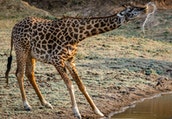- 1. Africa Giraffe Species There are four recognized species of giraffes: the Northern giraffe (Giraffa camelopardalis), Southern giraffe (Giraffa giraffa), Masai giraffe (Giraffa tippelskirchi), and Reticulated giraffe (Giraffa reticulata). Each species has distinct patterns and is adapted to different habitats.
- 2. Africa Giraffe Appearance: Giraffes are known for their long necks, which allow them to reach leaves on tall trees that other herbivores cannot access. They have a unique coat pattern with patches that vary in shape, size, and coloration, ranging from light tan to deep brown. The patterns are individualized, similar to human fingerprints, allowing for identification of individuals.
- 3. Africa Giraffe Size: Giraffes are the tallest land animals, with males reaching heights of up to 18 feet (5.5 meters) and females slightly shorter. They have long legs and a relatively small body compared to their neck and head. Adult giraffes can weigh between 1,800 and 3,000 kilograms (4,000 to 6,600 pounds).
- 4. Africa Giraffe Diet: Giraffes are herbivores, feeding mainly on leaves from trees and shrubs. Their long necks and tongues, which can measure up to 18 inches (45 centimeters), allow them to reach foliage at heights of up to 20 feet (6 meters). They are particularly fond of acacia trees but also consume a variety of other plant species.
- 5. Africa Giraffe Behavior: Giraffes are generally peaceful animals that live in loose social groups called towers or herds. They have a hierarchical structure, and males often engage in "necking" behavior, where they use their necks to engage in combat for dominance or mating rights.
- 6. Africa Giraffe Conservation Status: Giraffes are currently listed as a vulnerable species by the International Union for Conservation of Nature (IUCN). They face threats such as habitat loss, fragmentation, and poaching. Conservation efforts are underway to protect their populations and habitats.
- 7. Africa Giraffe Tourist Attractions: Giraffes are popular attractions for wildlife tourism in various African countries. National parks and reserves such as Kruger National Park in South Africa, Serengeti National Park in Tanzania, and Maasai Mara National Reserve in Kenya provide opportunities to observe giraffes in their natural habitats.
Africa Giraffe:
The giraffe is an iconic and distinctive animal found in various parts of Africa
Africa Safari Tour Book online Giraffes are remarkable creatures that symbolize the African savannah and its unique wildlife. Observing them in their natural environment is a captivating experience that highlights their grace, beauty, and incredible adaptations.
Here is some information about giraffes:
Africa Safari-Giraffe Tour - Visit Africa
An Africa safari focused on giraffe sightings can be an incredible experience. Here are some key points to consider when planning a safari tour with a focus on giraffes:
A safari focused on giraffes offers an opportunity to witness these magnificent animals in their natural habitat, learn about their behavior, and appreciate their conservation needs. With careful planning and the guidance of experienced professionals, you can create a memorable safari tour that highlights the beauty and diversity of Africa's wildlife, with giraffes as a captivating centerpiece.
Destinations
Discover Destinations: Several African countries offer excellent opportunities for giraffe sightings. Kenya, Tanzania, South Africa, Botswana, and Namibia are popular destinations known for their diverse wildlife and giraffe populations.
National Parks and Reserves
National Parks and Reserves: Look for national parks and reserves that are known for their giraffe populations. Serengeti National Park and Maasai Mara National Reserve in Kenya and Tanzania, Kruger National Park in South Africa, Chobe National Park in Botswana, and Etosha National Park in Namibia are renowned for their abundant wildlife, including giraffes.
Game Drives
Game Drives: Participate in game drives, which are guided tours conducted by experienced safari guides in open vehicles. These drives take you through the national parks and reserves, increasing your chances of spotting giraffes in their natural habitat.
Private Reserves and Conservancies
Private Reserves and Conservancies: Consider visiting private reserves and conservancies adjacent to national parks. These areas often offer more exclusive and intimate safari experiences, allowing for closer encounters with wildlife, including giraffes.
Walking Safaris
Walking Safaris: Some safari destinations offer guided walking safaris, allowing you to explore the bush on foot with experienced guides. This can provide a different perspective and a more immersive experience with giraffes and other wildlife.
Conservation and Research Centers:
Conservation and Research Centers: In certain areas, you may find conservation and research centers dedicated to giraffe conservation. These centers offer educational opportunities and the chance to observe and learn about giraffes up close while supporting conservation efforts.
Accommodations
Accommodations: Choose accommodations that are located within or near the national parks and reserves. Options range from luxury lodges and tented camps to budget-friendly options. Consider staying in properties that offer views of wildlife-rich areas or have private concessions with exclusive game-viewing opportunities.
Local Guides and Experts
Local Guides and Experts: Engage local guides and experts who have extensive knowledge of the area and wildlife behavior. Their expertise can enhance your safari experience and help you track giraffes more effectively.
Responsible Tourism
Responsible Tourism: Practice responsible tourism by following park regulations and guidelines, respecting wildlife and their habitats, and supporting conservation efforts. Minimize your impact by avoiding littering, maintaining a safe distance from animals, and adhering to ethical wildlife viewing practices.








 |
|  |
|  |
|  |
| 